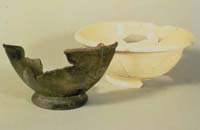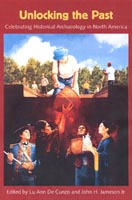Urban Life in Colonial Charleston, South Carolina
Martha Zierden

Colono ware and a comparable creamware bowl.
Charleston began in 1670 as a frontier city and quickly rose to prominence as the economic and social center of a wildly successful plantation system. Beginning about 1750, some white residents and investors made fortunes from rice and cotton grown by black bondsmen. They spent this money on material goods and social events that proclaimed their status. Then the city's fortunes declined with the Civil War and emancipation, and Charleston spent most of the last 150 years in economic stagnation. Today the city is once again booming, driven by a successful tourism industry and the desirability of coastal living to new residents and visitors alike. Both new development and renovation of historic buildings have prompted archaeological work.
Urban archaeology arrived in Charleston in the early 1970s, about ten years before I did, at a time when the discipline began to make inroads into other American cities like Alexandria. Urban planners, preservation administrators, and field archaeologists alike began to realize that archaeological remains could lie hidden beneath pavement and buildings, as well as beneath cornfields. This, plus federal grants for urban renewal and infrastructure, brought archaeologists, with their field and analytical tools, to the city. In Charleston, we expected archaeology to give us a view into the rigors of daily life for colonial and antebellum urban dwellers. How did these people feed, clothe, and maintain themselves when confronted with the issues particular to the city: population density, the close proximity of residences, commercial buildings, and even industries, and the increased availability of consumer goods? We also believed archaeology is a fruitful avenue to study all urban dwellers, not just those wealthy and powerful enough to leave a legacy of documents, houses, gardens, and heirlooms.
Sidebars:
- Sidebar 6: Archaeology of African Americans - Martha Zierden
- Sidebar 7: The Nathaniel Russell House Project - Martha Zierden
Martha Zierden is Curator of Historical Archaeology at The Charleston Museum.
